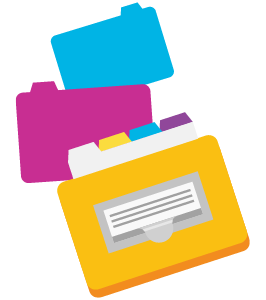Figuring out ways to save time might feel like just one more thing to do. But working more efficiently can result in more time to focus on creativity, check extra things off your list, spend extra time with your students, and maybe even find some time to relax.
Here are a dozen super-useful time-saving tips for you to try this school year! What will you do with all your free time once you start using these?

1. Choose Grading Battles
Because paper-grading is one of your most time-consuming tasks, streamlining your grading can end up being a huge time-saver. Instead of pointing out in detail every mistake in a student’s work, try just highlighting errors that relate directly to the purpose of the lesson. Your students will take away more from each graded assignment, and you’ll find that you can cut your grading time in half.
Bonus Tip: Grade all your papers before entering your grades in your grade book, instead of one at a time!

2. Paper Management
Forms, letters, announcements, memos, tests, and other paperwork can bury even the most organized teachers. Try these tricks for managing the mess:
- Keep all paperwork divided into categories: To Do, To File, To Read, To Hold.
- Once a week, schedule an hour just for organizing, decluttering, and filing papers.
- Use colored file folders to organize papers by subject, class period, and student.
- If it’s been more than a year since you’ve looked at a paper, recycle it. Be ruthless.
- Wherever possible, go paperless! Store things digitally whenever you can.
- Use drawers and bins to designate spots for different types of paper, like tests, essays, quizzes, lesson plans, student info, correspondence, etc.

3. Talk Less
Of course it’s important to have meaningful and useful conversations with your students. And as you know, a lot of the time teaching means talking! But it’s quite possible that you’ll discover the less talking you do, the more your students learn and the more efficient your lessons will be. Make it a goal to deliver fast, focused lessons.
Try setting a timer for lessons and observe where you are in the lesson when the timer goes off. Should you spend less time on introductions, or on examples? Using this exercise will help you stay aware of how you pace your lessons and of which types of talking are most efficient and beneficial.

4. Set Boundaries
Watch out for your own time-wasting habits and start setting boundaries for yourself. You’ll find big time savings result from making simple changes throughout your day. Keep track of things that suck time out of your hands and work to eliminate them consistently. A little self-discipline will go a long way toward recharging your batteries. Here are some common culprits, but be sure to watch out for your own! Just say no to:
- Spending too much time rehashing your day in team planning meetings.
- Checking social media, or spending too much time scrolling through emails.
- Stopping to chat with coworkers in the breakroom, or on your way to grab your mail.
- Hanging out with other teachers in their rooms before or after your classes.
- Staying late for extended or unnecessary phone conferences with parents.
Bonus Tip: Before phone calls, write down all the points you’ll discuss, so you can get right to the point.

5. Make Lists
Writing everything down, whenever you think of it, all the time, on a to-do list means you can avoid that nagging feeling that you’ve forgotten something you thought you’d remember. Keep it easily accessible and update it every single time you think of something, no matter how small, that you need to accomplish or complete.
A comprehensive list ends up being a time-saver because 1) you know you’ve kept it up to date, 2) it helps you prioritize what you’ll do next, and 3) checking things off the list means you’re actually getting things done.
Bonus Tip: Figure out your biggest priority, or perhaps the odious thing you’ve been putting off, and get it done first. Your sense of satisfaction will be the ultimate reward.

6. Zone In On Time-Wasters
Figure out which tasks are taking way too long, and knock them out as early and as fast as you can. Whatever it is (grading, making copies, etc.) pick a day to start early (when fewer people are around and the school is quieter) and dig right in to that task. Attack it with determination, remembering that your goal is to get it done quickly, and see how much faster than you usual you can complete it. Then, revel in the time you’ve saved. Practice doing this every week and see what a difference it makes!

7. Done is Better Than Perfect
Sometimes there just aren’t enough hours in the day. Lowering your standards may be unthinkable to you, but remember you’re not doing this everywhere – only in situations where you can handle it. Only when you just have to get the job done, but it’s not imperative for it to be perfect in every way.
For example: not every chart or handout has to be a beautiful work of art. Do you need to make sure the font you’ve chosen is the best possible one? Do you have to hand-write the title and draw original art in the corners? No. These added steps likely won't change the end result for your students. By getting it done and moving on, you're saving yourself incredibly valuable time and energy that can be directed to the things that really do matter.

8. Block Out Distractions
Whenever you need to work on something alone (grading, reading, planning, studying, professional development, filing, etc.) be sure to eliminate any potential interruptions or distractions. Find a quiet place to work, like the library, or an empty classroom.
Turn off your phone. Surround yourself with only the essential items needed for the task. Allow nothing to divert your attention. Force yourself to adopt an attitude of laser focus. You’ll find that you’ve maximized this time, completed essential tasks, and freed up the rest of your day for other things.

9. Fast Focus
Taking too long to get students settled in when class starts? Try timed activities that start right after the bell rings. Anything from a pop quiz to a game or discussion can get your students on task quickly and make sure everyone gets focused fast, saving precious minutes of class time.
Bonus Tip: Using this activity to take roll is a great way to save even more time at the start of class!

10. Batching Works
Instead of getting things done one at a time, start completing tasks in larger batches, less frequently. Don’t walk over to the photocopier every time you need to make copies. Pull everything together that you need for the whole week and get it done in one big trip to the copy room. Don’t open your email a dozen times a day and re-read the same message several times before responding. Check your email twice a day, read each message once, and respond to all of them before closing your email. Apply this batching mentality to every task you can think of, and watch how much time opens up.

11. Work Digitally
Streamline everything from paper to distribution time by assigning and completing things online whenever you can. Store documents digitally for easy organization and retrieval. Save loads of time by collecting and assessing student work electronically. With powerful tools like Raz-Plus, you can review and grade work digitally, while your students receive your feedback faster too, allowing them to review it before class or when they’re absent, and even allowing better communication between home and school.

12. Use Your Last 10 Minutes
The last 10 minutes of the school day, everyone’s mind is already out the door. Instead of allowing this to make you feel frustrated, take advantage of it by giving the kids something relaxing and calm to focus on while you quickly organize yourself, your desk, your room, or your files for the next day. Or if they’re up for it, students can help out with simple jobs like stacking chairs, wiping the board, etc. A few other things you can get done during this time include:
- Making neat piles of papers to copy or file.
- Typing up notes, plans, or slides to use tomorrow.
- Creating a list of things to do first thing in the morning.
- Cleaning up clutter or put things away so you arrive to a clean space the next day.
Avoid burnout, feel more energized, get more done, and streamline your productivity. When you’ve got a little breathing room, you’ll probably realize you’re doing a fantastic job as a teacher.
Try these amazing time-saving tips and you’ll hit the ground running this year!
Want to see how much time you can save by using Raz-Plus in your classroom?


